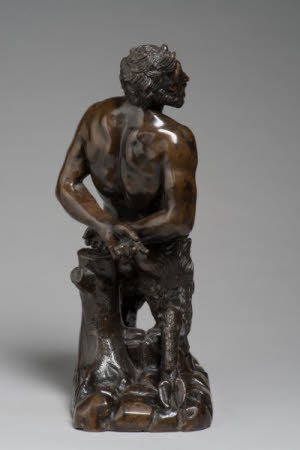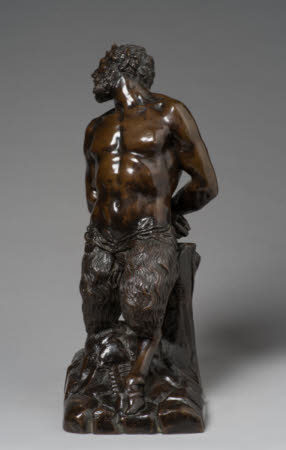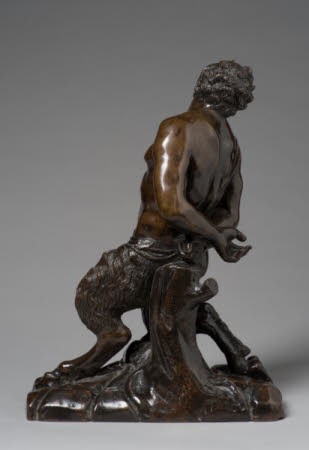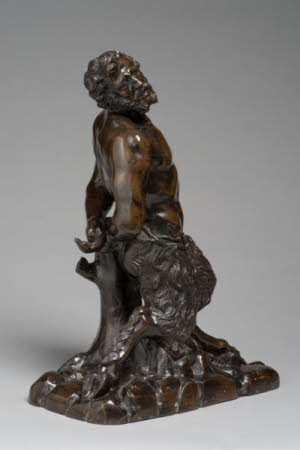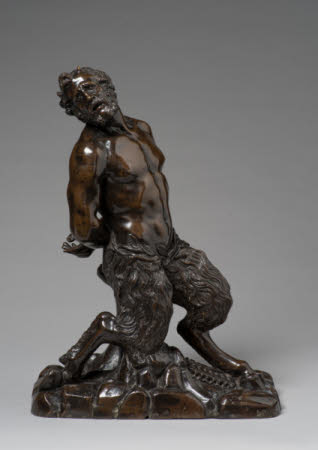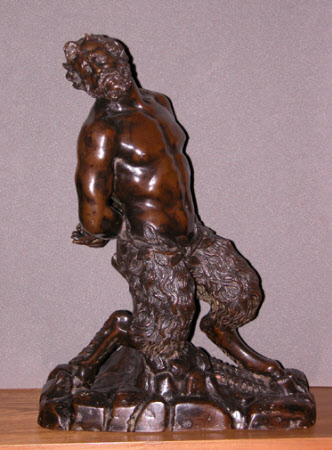Marsyas
probably Italian (Roman) School
Category
Art / Sculpture
Date
1600 - 1650
Materials
Bronze
Measurements
416 x 298 x 165 mm
Place of origin
Rome
Order this imageCollection
Anglesey Abbey, Cambridgeshire
NT 515031
Summary
Bronze, Marysas, Italian (probably Roman) School, c. 1600-1650. An Italian 17th-century bronze figure of the satyr Marysas, shown in a crouching position, his right knee on the ground, his hands bound and his body jerked back in fear. He is shown as he is about to be flayed alive by the god Apollo, the winner of a musical competition between the two.
Full description
The story of the contest between the sun god Apollo and Marsyas, a satyr and follower of Bacchus, is one of the most unpleasant and violent in all Classical mythology. The goddess Minerva had invented the flute but, angry at being laughed at when her cheeks bulged as she played it, she had thrown away the instrument, laying upon it a curse as she did so. The flute was found by the hapless Marsyas, who became skilled at playing the instrument. Indeed, his reputation became such that he enraged Apollo, who challenged the satyr to a musical contest, suggesting that the winner be permitted to impose whatever penalty he chose on the other. Having named his own followers the Muses to be the judges, Apollo inevitably won the contest, upon which he announced his intention of flaying Marsyas alive. The bronze seems to show the satyr, whose hands have been bound, leaning backwards and screaming as he struggles to avoid his impending fate. The story is told by the Roman poet Ovid in his Metamorphoses (VI. 382-98), a poem that describes a series of transformations of living beings, usually at the agency of one or more of the gods. In the case of the flaying of Marsyas, it was not in fact the satyr’s blood that effected the transformation, but rather the tears of the human and mythological inhabitants of the surrounding countryside, which sank into the ground to form the river Marsyas. The scene of the flaying of Marsyas may be seen in a bronze group by the Florentine sculptor Giovanni Battista Foggini, examples of which are in the Peter Marino collection and in the Victoria and Albert Museum (Jeremy Warren, Beauty and Power. Renaissance and Baroque Bronzes from the Peter Marino Collection, exh. cat., Wallace Collection, London 2010, no. 21; Eike D. Schmidt, Sandro Bellesi and Riccardo Gennaioli, eds., Plasmato dal Fuoco. La scultura in bronzo nella Firenze degli ultimi Medici, exh. cat., Palazzo Pitti, Florence, Livorno 2019, no. 37). It is possible that the Anglesey Abbey figure of Marsyas originally formed part of a two-figure group, with a separately made statuette of Apollo standing over the satyr and wielding his knife. However, the image of Marsyas makes a moving impact on its own, so possibly it was intended from the beginning to be seen on its own. Other versions of the model are known. One was formerly in the collection of Prince Gonzaga in Mantua, and later in the Harding collection, Chicago, and was sold at auction in 1985 (Sotheby’s New York, 10 May 1985, lot 198). Another version was formerly in the collection of George Encil, where it was catalogued as an Italian work, perhaps Tuscan, made c. 1530-60 (George Encil, Experience and Adventures of a Collector, Paris 1989, pp. 326-28). It was sold at auction in 1990 (European Sculpture and Works of Art, Sotheby’s, London, 13 December 1990, lot 147). This example had been in the collection of the Amsterdam dealers J. and S. Goldschmidt in the 1920s, who sent a photograph to the great German authority on bronzes, Wilhelm von Bode. Bode replied in a letter of 6 March 1925 that he thought the bronze the work of the Paduan sculptor Riccio (Andrea Briosco, 1470-1532), ‘the strong careful execution’ suggesting a work from Riccio’s very late period. Having only seen a photograph, Bode may have thought the bronze was much smaller than it in fact is. Yet another example was sold in Florence in 2020 (Oggetti d’Arte e Sculture, Pandolfini, Florence, 30 June 2020, lot 125, as French, 19th century). Despite Bode’s enthusiasm, this fine bronze is not in fact by Riccio, nor was it made as early as the sixteenth century. The fresh and vigorous working of the surface might rather suggest it was made in Rome, probably in the first half of the seventeenth century. Jeremy Warren October 2021
Provenance
Bequeathed to the National Trust by Huttleston Rogers Broughton, 1st Lord Fairhaven (1896-1966) with the house and the rest of the contents.
Credit line
Anglesey Abbey, The Fairhaven Collection (The National Trust)
Makers and roles
probably Italian (Roman) School, sculptor
References
Warren 2010: Jeremy Warren, Beauty and Power. Renaissance and Baroque Bronzes from the Peter Marino Collection, exh. cat., Wallace Collection, London 2010, no. 21. Schmidt, Bellesi, and Gennaioli 2019: Eike D. Schmidt, Sandro Bellesi and Riccardo Gennaioli, eds., Plasmato dal Fuoco. La scultura in bronzo nella Firenze degli ultimi Medici, exh. cat., Palazzo Pitti, Florence, Livorno 2019, no. 37. Christie, Manson & Woods 1971: The National Trust, Anglesey Abbey, Cambridge. Inventory: Furniture, Textiles, Porcelain, Bronzes, Sculpture and Garden Ornaments’, 1971, p. 137.
